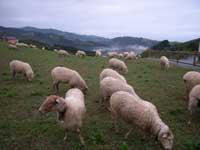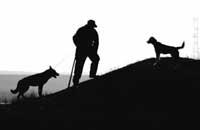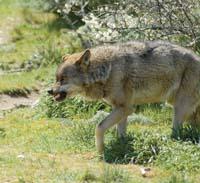Some famous and others
2010/02/07 Lakar Iraizoz, Oihane - Elhuyar Zientzia

In the Basque Country, the most populated area of wolves is that of Alava, which is considered the eastern limit of the Iberian population of the European wolf. In this area, the latxa sheep are the most abundant sheep. Sheep are often unfenced and not always under the watchfulness of shepherds.
Many times it is reported that these sheep have been attacked by wolves, which has provoked clashes between peasants, managers and agencies and groups in favor of the conservation of wolves. And governments are spending a lot of money on it. According to official data from the Provincial Council of Alava, during the years 2003-2004 432 animals were attacked, of which almost 400 were sheep. Well, 94% of these attacks were attributed to wolves and the Alava Council spent more than one hundred thousand euros in remuneration and prevention of attacks of wolves.

Álava is considered the eastern limit of the population of the European wolf of the Iberian Peninsula, with latxa sheep being the most abundant races in the area (Photo: José Antonio Gil) .
Do not clarify to the detriment of wolves
These kinds of things have given very bad fame to wolves and are suffering a great persecution. "Harassment is probably so unfair," says Jorge Echegaray, one of the researchers who carried out the study. In fact, they rarely take into account that in addition to wolves, dogs that have become wild or are not controlled are able to attack the sheep. They rarely measure the responsibility of these dogs in the predation of livestock. For example, during the aforementioned period, dogs were only charged with 10 attacks.
Dogs that have become wild and are not controlled are common, but technically it is difficult to distinguish if the attacks have been produced by wolves or dogs. However, if the objective is to adequately reconcile wildlife and the performance of farmers, it is essential that they be able to do so. Researchers have shown that genetic methods are a useful tool for developing such programs.
During the study, 136 excrements that looked like wolves were collected and, through genetic methods of personal identification, it was found that there was a separation between excrement of wolves or dogs. Of all the collected, 86 were able to identify the animal of origin: 31 were wolves, 2 of azereta and 53 of dogs.

The belief that sheep suffer attacks of wolves provokes conflicts between peasants, managers and agencies and groups in favor of the conservation of wolves (Photo: Alfonso Benayas).
When analyzing the remains of prey found in the excrements of wolves and dogs, it was verified that each excrement had remains of a single prey. Of 30 wolf excrements, 22 found remains of wild prey: seventeen of deer, three of boars, one of azkons and one of hares. Eight other wolf excrements contained remains of cattle; four of horses, three of cows and one of sheep.
In the dejections of the dogs, 39 dams were identified. Of these, 14 (36%) had sheep remains and seven (18%) had remains of horses or cows. Thus, the cattle occupied 54% of the predators identified in the dejections of the dogs.
In view of these results, Echegaray argues that the Council should question whether it is "correct" to continue accusing wolves of most attacks, which should serve to "properly design preventive and retributive programs" and minimize the conflict between natural predators and society.
Published in 7K.

Gai honi buruzko eduki gehiago
Elhuyarrek garatutako teknologia




